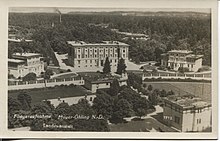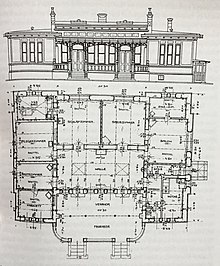State Hospital Mauer
| State Hospital Mauer | |
|---|---|
| place | Wall near Amstetten |
| Country | Austria |
| Coordinates | 48 ° 5 '33 " N , 14 ° 48' 21" E |
| founding | 1902 |
| Website | mauer.lknoe.at |
The Landesklinikum Mauer (also Landesklinikum Amstetten-Mauer ) is a psychiatric and neurological center and teaching hospital in Mauer near Amstetten . It was planned and designed by Carlo von Boog and Erich Gschöpf according to the most modern guidelines in Art Nouveau and was considered a model for the Klinik Am Steinhof . The complex is considered the most important Art Nouveau ensemble in Lower Austria .
history
The state sanatorium and nursing home for the mentally ill was planned from 1898 to 1902 as an Art Nouveau pavilion by Carlo von Boog according to the latest medical principles and the latest psychological findings and was the model for the later Am Steinhof sanatorium . While the name of the state building director von Boog remained closely associated with the sanatorium, the name of the architect who carried out the work, Erich Gschöpf , is largely unknown today.
What is remarkable about the architectural design is, on the one hand, the extensive use of iron or cast concrete. On the other hand, the early use of rich secessionist decorative forms is striking, especially since the plans were made before 1898. In part, Gschöpf made use of floral or vegetal Art Nouveau forms , but he also took up typical motifs of the Wagner school , such as laurel wreaths or angel heads. The protruding, flat roofs also point to Otto Wagner.
The facility was inaugurated by Emperor Franz Joseph in 1902 . He is said to have said the following sentence when he was shown the facility:
"It must be nice to be a fool in Mauer."
And in fact, the open construction of the institution with 19 pavilions in the middle of a huge park represents a quantum leap in the care of the mentally ill, compared to the baroque asylums like the Narrenturm in Vienna. The convenient location on the Westbahn in terms of traffic and the enormous capacity (1000 patients) was chosen in order to ensure that, in addition to supplying Lower Austria, patients from the metropolis of Vienna at the time were also looked after.
time of the nationalsocialism
In the time of National Socialism there were also murders, among others by Emil Gelny . Between June 1940 and August 1941, up to 1,600 patients from Mauer-Öhling were murdered by gas in the Hartheim Castle killing center near Linz . The murder continued after that. Czech estimates that a total of 2,700 patients in the clinic were murdered by gassing, electric shocks, poisoning, and systematic starvation.
Rothschild Pavilion
In 1907 Albert Rothschild's bipolar son , Georg Rothschild, was brought to Mauer. Following the care village, a separate villa was built, which was stylistically based on Otto Wagner's Art Nouveau villas and described as particularly successful by the architectural historian Peter Kunerth and ascribed to the architect Erich Gschöpf by him. It had a hall with a veranda, a salon and a farmhouse parlor, a dining room, bedroom, kitchen, bathroom and two nursing rooms with a large veranda on a floor space of around 200 square meters.
The choice fell on the Mauer location not least because it was halfway from Vienna to Waidhofen to the Rothschild estates and easily accessible by train. Georg Rothschild spent a good 30 years there, constantly cared for by a doctor and three guards, which in the late 1920s aroused more and more displeasure, as the province of Lower Austria had to bear the majority of the costs. Rothschild died of dementia in 1934 , and the villa was torn down in 1975.
Facility
Today, in addition to the acute psychiatric department, the state clinic also houses facilities for alcohol cessation , drug withdrawal , forensic psychiatry , psychosomatic medicine , child and adolescent psychiatry , sociotherapy and rehabilitation . There are also three neurological departments with an awake comastation, an internal geriatric ward and several nursing homes.
chapel
A representative rectangular building under a flat roof with a roof turret on the east side . The west facade was renewed in reduced forms in 1958.
See also
literature
- Clemens Arthur Ableidinger: Everything for the good of the fools. The influence of the First World War on the Kaiser Franz Joseph sanatorium and nursing home Mauer-Öhling . Diploma thesis, Vienna 2017.
- Herwig Czech: From “Aktion T4” to “decentralized euthanasia”. The Lower Austrian sanatoriums and nursing homes. Gugging, Mauer-Öhling and Ybbs. In: Documentation archive of the Austrian resistance (ed.): Fanatiker, Duty Fulfiller, Resistance. Reichsgaue Niederdonau, Greater Vienna, Vienna 2016 (= yearbook 2016).
- Michaela Gaunerstorfer: The psychiatric sanatorium and nursing home Mauer-Öhling 1938–1945. Diploma thesis, Vienna 1989.
- Elisabeth Koller-Glück, Peter Kunerth: Carlo von Boog and Mauer-Öhling. The Kaiser Franz Joseph-Landes sanatorium and nursing home Mauer-Öhling. An art nouveau jewel in Lower Austria. Verlag Niederösterreichisches Pressehaus, Vienna 1988, ISBN 3-85326-863-3 .
- Roman Sandgruber: Rothschild. Glory and decline of the Viennese world house. Molden Verlag, 2018.
Web links
Individual evidence
- ^ Henry Friedlander: The Origins of Nazi Genocide. Univ. of North Carolina Press, 1997, ISBN 978-0-8078-4675-9 , p. 354 ( limited preview in Google Book Search).
- ↑ Philipp Mettauer: The "sanatorium and nursing home" Mauer-Öhling in the Nazi era. Care Professional, April 4, 2017.
- ^ The Lower Austrian “sanatorium and nursing home” Mauer-Öhling during the Nazi era. Institute for Jewish History in Austria.
- ↑ H. Czech: From “Aktion T4” to “decentralized euthanasia”. The Lower Austrian sanatoriums and nursing homes Gugging, Mauer-Öhling and Ybbs. In: Yearbook of the Documentation Archive of the Austrian Resistance. 2016, cit. according to G. Gazdag, GS Ungvari, H. Czech: Mass killing under the guise of ECT: the darkest chapter in the history of biological psychiatry. In: History of Psychiatry. Volume 28, No. 4, pp. 482-488, here p. 485.




